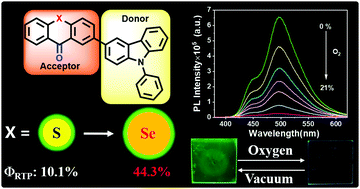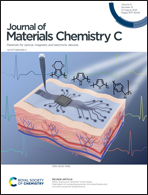A highly efficient purely organic room-temperature phosphorescence film based on a selenium-containing emitter for sensitive oxygen detection†
Abstract
Developing purely organic room-temperature phosphorescence (RTP) materials with high phosphorescence efficiency in film states is important for their applications but remains a great challenge. Herein, a donor–acceptor type RTP molecule (SeX-CzPh) with 9H-selenoxanthen-9-one and 9-phenyl-9H-carbazole as the acceptor and donor units, respectively, is designed and synthesized. SeX-CzPh shows a high phosphorescence quantum yield of 44.3% in a doped polystyrene film at room temperature, which is 4-fold higher than that of its analogue TX-CzPh with 9H-thioxanthene-9-one as the acceptor unit. The heavy selenium atom plays a key role in achieving high phosphorescence quantum yields, owing to the effective ISC process through strong spin–orbit coupling. Moreover, the SeX-CzPh-based oxygen film sensor exhibits a wide detection range (0–2.1 × 105 ppm), a high KSV (1.27 × 10−4 ppm−1) and a low detection limit (4.9 ppm). This work demonstrates that 9H-selenoxanthen-9-one is a promising building block for the rational design of highly efficient purely organic RTP materials.



 Please wait while we load your content...
Please wait while we load your content...